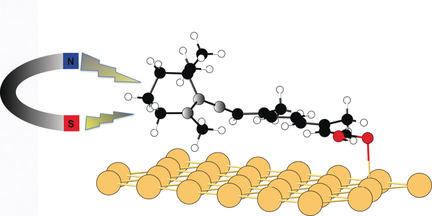
Inert metal surfaces present more chances of hosting organic intact radicals than other substrates, but large amounts of delocalized electronic states favor charge transfer and thus spin quenching. Lowering the molecule–substrate interaction is a usual strategy to stabilize radicals on surfaces. In some works, thin insulating layers were introduced to provide a controllable degree of electronic decoupling. Recently, retinoid molecules adsorbed on gold have been manipulated with a scanning tunneling microscope (STM) to exhibit a localized spin, but calculations failed to find a radical derivative of the molecule on the surface. Now the formation of a neutral radical spatially localized in a tilted and lifted cyclic end of the molecule is presented. An allene moiety provokes a perpendicular tilt of the cyclic end relative to the rest of the conjugated chain, thus localizing the spin of the dehydrogenated allene in its lifted subpart. DFT calculations and STM manipulations give support to the proposed mechanism.

N’hésitez pas à consulter le communiqué de presse associé à cet article :
Quand des molécules non-magnétiques organiques se transforment en aimant !
Également un communiqué de presse (en anglais) provenant de Mapping Ignorance :
Spin in a closed-shell organic molecule stabilized on a metallic surface
References:
Spin in a Closed-Shell Organic Molecule on a Metal Substrate Generated by a Sigmatropic Reaction
Marie-Laure Bocquet, Nicolas Lorente, Richard Berndt, and Manuel Gruber
Angew. Chem. Int. Ed. 2019, 58, 821
DOI: 10.1002/anie.201812121
Spin in a Closed-Shell Organic Molecule on a Metal Substrate Generated by a Sigmatropic Reaction
